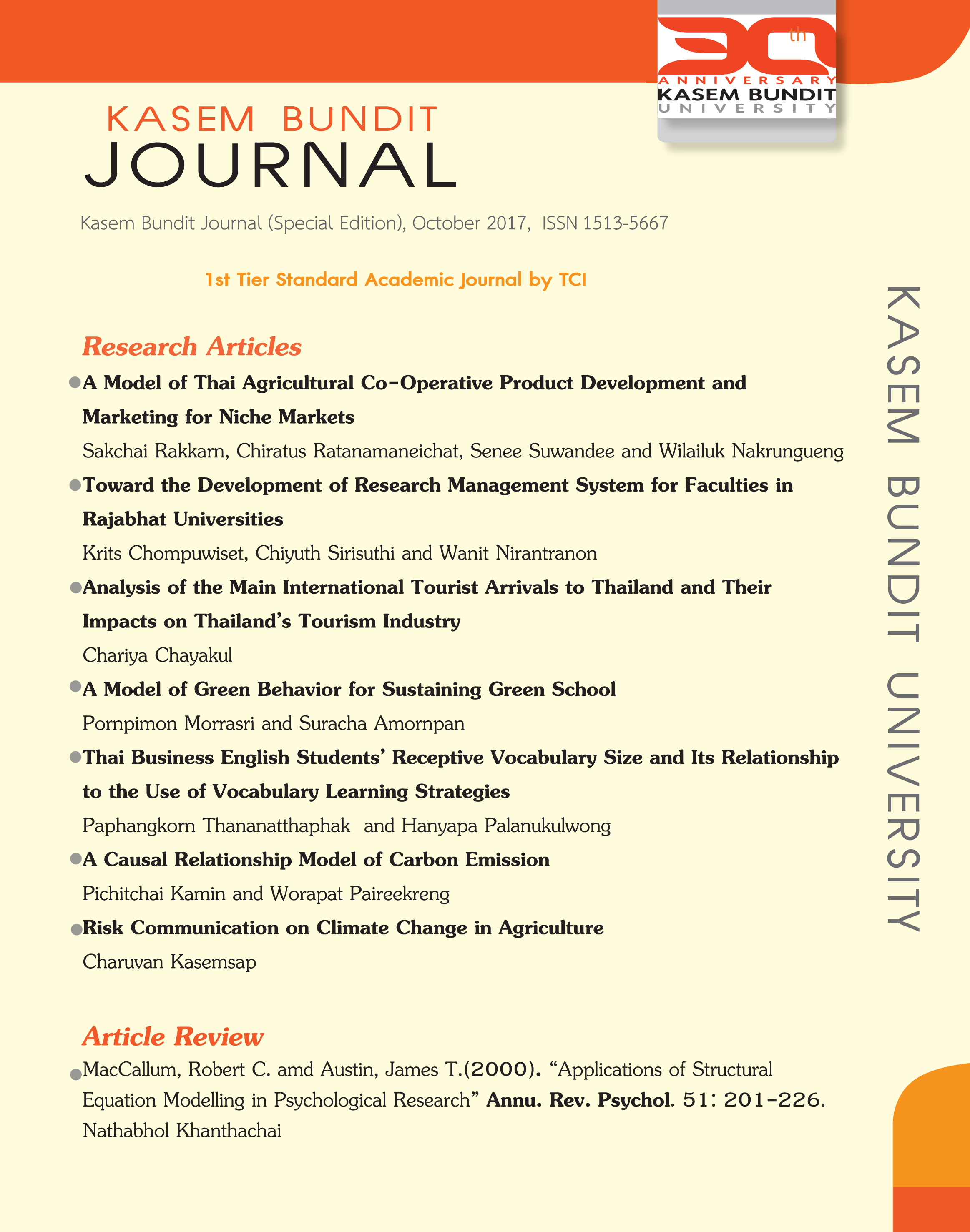Causal Relationship between Smartphone Usage Behavior and Carbon Emission
Keywords:
Smartphone, Behavior, Smartphone usage patterns, Attitudes towards smartphone usage, Carbon emissionsAbstract
The main purpose of this research was to study the causal relationship between smartphone usage behavior and carbon emission. The sample consisted of 400 students of Mahasarakham Rajabhat University during the second semester of the 2016 academic year. By means of structural equation modeling, it was revealed that behavioral usage of smartphones (BIS) was significantly influenced by factors of acquiring smartphones (FAS) and attitudes toward carbon emission of smartphone usage (ATE) for 45 percent. Moreover, both usage patterns of smartphones (UPS) and FAS influenced ATE significantly for 52 percent.
References
Ericsson, C. (2012). Features and Usability of Smart Mobile Users in Thailand. (online). Retrieved from: http://www.thaipr.net/communication/429388 [September 27, 2016]
Information Technology Management (2014). Impact of information technology. (Online). Retrieved from: https://thanchanok07.wordpress.com/ [September 27, 2016]
Joreskog, K. G. and Van Thillo, M. (1972). LISREL: A General Computer Program for Estimating a Linear Structural Equation System Involving Multiple Indicators of Unmeasured Variables (RB-72-56). Princeton, NJ: Education Testing Service.
Joreskog, K.G. and Sorborn, D. (1981). LISREL: Analysis Structural Relationship by method of maximum likelihood (Version V). Chicago: National Educational Resources, Inc.
Jumrearnsan,W et al (2012). Development of an Environmental Education Model for Global Warming Alleviation. The Social Sciences, 7: 65-70.
Kachintorn, Nattaya (2008). Green IT. Daily News Newspaper. (2 May 2008)
MongKhonvanit, Pornphisud (2013). Life is changing with the use of smartphones. (online). Retrieved from: http://www.etpnews.com/index.php?option=com_content&view = article&id=354:2013-03-16-01-48-38&catid=38:breaking-news&Itemid=59 [September 27, 2016]
Mungkung, Rattanawun et al (2010). “Carbon Fotprinting of Rice Products”. Kasetsart Engineering Journal. Vol.24(75) p53-60.
Rovinelli R.J. and Hambleton R.K. (1977) On the use of content specialists in the assessment of criterion-referenced test item validity. Dutch Journal of Educational Research, Vol 2, p49-60.
Sureerattanan, Songyot (2010). Green IT: A Sufficient and Sustainable Information Technology. The Journal of KMUTNB, Vol. 20(2) p393-398.
Khampachua, Tawa (2009). “Green Information Technology”. Information Technology Journal, 5(9) p 63-66.
Thailand Greenhouse Gas Management Organization (Public Organization) (2016). Carbon footprint assessment in Thailand. (online). Retrieved from: http://www.tgo.or.th [20 May 2017]
The Registrar (2017) Statistics Total number of students. (Online). Retrieved from: https://academic.reru.ac.th/download/2560/statistic-59-2-0.pdf [February 16, 2017]
Watokung (2016). Top 5 Mobile brand with first-half sales growth 2016. Retrieved from:https://www.marketingoops.com/reports/metrix/top-5-brand-mobile-increased-sales/ [September, 2 2016]
Yamane, Taro (1973). Statistics: An Introductory Analysis. Third editio. Newyork : Harper and Row Publication.
Downloads
Published
How to Cite
Issue
Section
License
ทัศนคติ ความคิดเห็นใด ๆ ที่ปรากฏในวารสารเกษมบัณฑิตฉบับนี้เป็นของผู้เขียน โดยเฉพาะ มหาวิทยาลัยเกษมบัณฑิตและบรรณาธิการ ไม่จำเป็นต้องมีความเห็นพ้องด้วย







